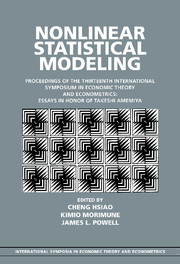 Nonlinear Statistical Modeling
Nonlinear Statistical Modeling Published online by Cambridge University Press: 05 June 2012
Introduction
Takeshi Amemiya made basic contributions to the econometrics of discrete choice and limited dependent variable models. His fundamental 1973 paper on the censored normal regression model was the first systematic application in econometrics of the uniform law of large numbers and the central limit theorems required to establish consistency and asymptotic normality of nonlinear econometric models. That paper and his later work on nonlinear least squares are summarized in his magisterial text Advanced Econometrics (1985). His research and his text set the standard for a generation of econometricians, and provided the framework for modern structural econometric analysis of index models or latent variable models.
Latent variable models of the type analyzed by Amemiya arise in wellposed economic problems. The latent variables can be utilities, potential wages (or home wages as in Gronau 1974 and Heckman 1974) or potential profitability. This class of models, which originates in psychology in the work of Thurstone (1930, 1959), has been widely developed in the econometrics of discrete choice (see McFadden 1981, and the survey of index models in labor economics presented by Heckman and MaCurdy 1985). Amemiya provided the econometric foundations for the application of these methods to numerous economic problems.
This paper uses the latent variable or index model of econometrics and psychometrics to impose structure on the model of Neyman (1923)–Fisher (1935)–Cox (1958)–Rubin (1978) of potential outcomes used to define treatment effects.
To save this book to your Kindle, first ensure [email protected] is added to your Approved Personal Document E-mail List under your Personal Document Settings on the Manage Your Content and Devices page of your Amazon account. Then enter the ‘name’ part of your Kindle email address below. Find out more about saving to your Kindle.
Note you can select to save to either the @free.kindle.com or @kindle.com variations. ‘@free.kindle.com’ emails are free but can only be saved to your device when it is connected to wi-fi. ‘@kindle.com’ emails can be delivered even when you are not connected to wi-fi, but note that service fees apply.
Find out more about the Kindle Personal Document Service.
To save content items to your account, please confirm that you agree to abide by our usage policies. If this is the first time you use this feature, you will be asked to authorise Cambridge Core to connect with your account. Find out more about saving content to Dropbox.
To save content items to your account, please confirm that you agree to abide by our usage policies. If this is the first time you use this feature, you will be asked to authorise Cambridge Core to connect with your account. Find out more about saving content to Google Drive.